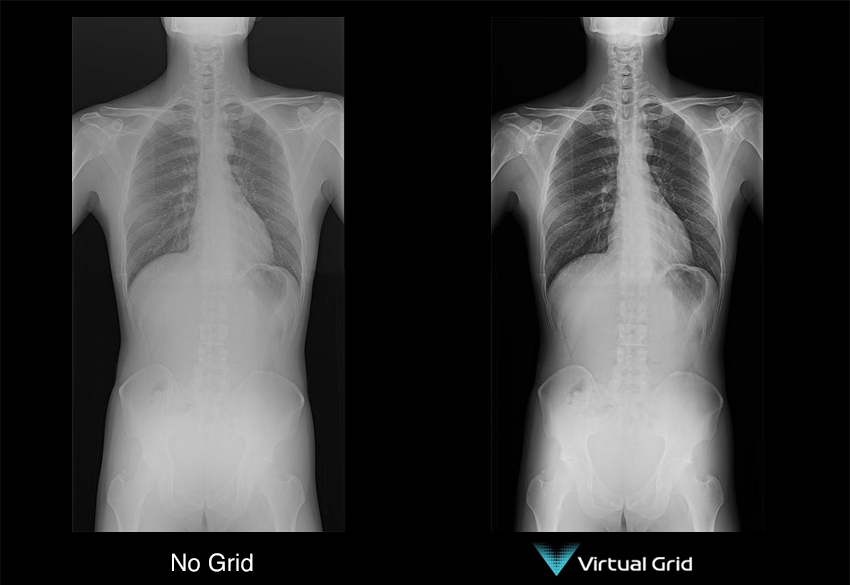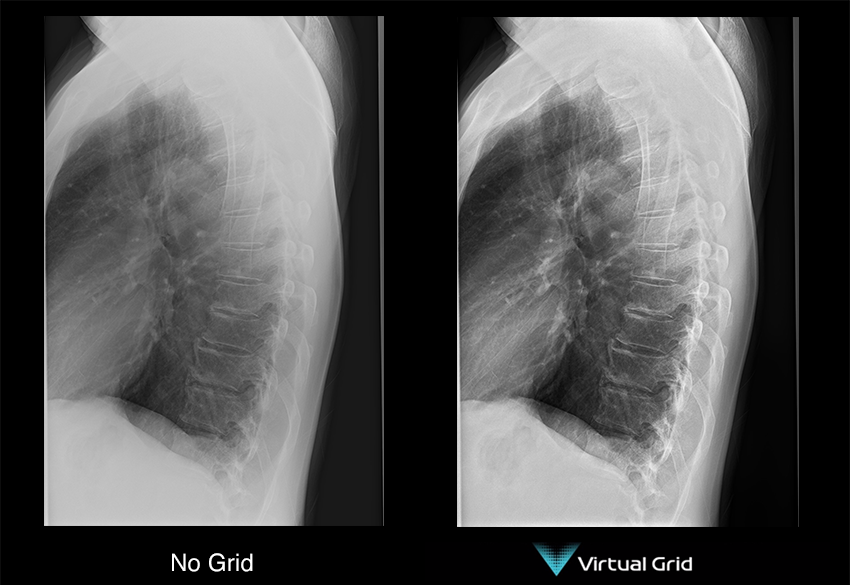Introduction
Virtual Grid is a modern radiography innovation that allows a medic to reduce scattering with the help of digital reconstruction of a radiograph. Furthermore, a consequence of its use is an increase in the clarity of a radiograph and a decrease in the veil on an image, subverting an X-ray image’s value. The Grid is used, in particular, in studies where a large amount of scattering is created, that is, those associated with a large volume of irradiated tissue and those that require low energy, that is, voltage. Otherwise, scattering would degrade the image due to reduced contrast and resolution. However, this invention has not yet been thoroughly studied, having a small amount of precise and reliable information. Thus, this seminar paper aims at a comprehensive and detailed analysis of Virtual Grid in radiography in terms of generalized characteristics, components and functional features, advantages and disadvantages, relevant statistical data, as well as expected changes and applications in practice.
Background Information about the Technology
Virtual Grid is one of the latest technologies in radiography from the world-famous Japanese company Fujifilm. This product offers a vast range of grid coefficients in order to increase and improve the contrast and clarity of images during research by adjusting the effects of scattered radiation (Gentle touch brilliant image, n.d.). Virtual Grid quickly predicts and corrects the effects of radiation scattering by making high-quality pictures. In general, Virtual Grid, with the help of low dose levels, can provide contrast images compared to that offered by a hardware grid. Moreover, the innovation eliminates slice artifacts and is configured to emulate chosen grid elements.
Furthermore, this invention is indispensable in complex cases and situations when the task of applying the grid in practice is impossible. For example, when there is no optimal grid on hand for specific exams or “mobile visualization” is at frequent risk of misalignment of the tube’s angle of inclination and SID (Gentle touch brilliant image, n.d.). The developers claim that Virtual Grid can be applied to any part of the body, including the head, spine, chest, abdomen, pelvis, as well as lower and upper limbs (Gentle touch brilliant image, n.d.). Thus, the Fujifilm project not only provides the convenience of a patient during exams but also increases the productivity of a workflow.
Major Components and Functions of the Technology
Virtual Grid is a relatively new phenomenon in the field of radiography that does not use a physical grid. Many professionals are confident that Virtual Grid will become a technology of the future, while physical grids will be permanently abolished and “sink” into the past (Bell, 2020). Excluding “real” components, Virtual Grid focuses on a special algorithm that appeals to fundamental mathematics in terms of Gaussian decomposition, Laplace, and wavelet transformations (Bell, 2020). Therefore, such an algorithm subsequently iteratively reconstructs the radiograph. In addition, this method can remove scattered radiation and enhance image contrast for various body thicknesses. At the same time, the resulting image does not differ significantly from a grid radiograph.
Furthermore, it should be emphasized that Virtual Grid in radiography has an extensive range of functionality and possible variations of its use required by some medical experts. Virtual Grid technology allows one to correctly and precisely adjust the effects of scattered radiation to eliminate the fuzziness, fading, and blurriness of images obtained without an anti-scattering grid (Virtual GridTM, n.d.). Indeed, the functional ability and performance of the grid depending on the grid ratio representing the ratio of the height of the lead strips to the distance between the two strips (the interspace) (Er, 2022). This is the most critical parameter affecting the anti-scattering grid’s performance. The innovation is often necessary to create mobile images of large anatomical structures within the framework of radiation focusing. Consequently, due to the main internal components and intelligent processes, this Fujifilm project can quickly analyze an image for the presence of scattering effects, presenting automatic and selectable grid ratios for further adaptation of roentgen quality. In the vast majority of cases, this procedure takes place on the basis of the exam menu and the selected parameters.
Advantages of the New Technology
Primarily, a wide range of advantages, benefits, and positive aspects of Virtual Grid in Radiography are worth attending to. Thus, one should highlight that Virtual Grid is one of the most advanced and exciting technologies of the 21st century, enhancing image quality for various experimental conditions (Gossye et al., 2020). As a rule, the process of quality improvement with the help of this innovation is achieved by increasing the contrast and clarity of pictures with a reduced radiation dose (Virtual GridTM, n.d.). In general, Virtual Grid provides a more efficient, productive, and structured radiographic procedure, eliminating various hindrances, difficulties, defects, and obstacles caused by misalignment when using a grid (Kawamura et al., n.d.). Consequently, Virtual Grid plays an essential role in creating high-quality X-ray images, suppressing scattered radiation, and transmitting most of the primary radiation.

In addition, this technology’s scope is extensive, multifaceted, and diverse in its essence and nature. Hence, from the point of view of simulating the actual use of a grid, the project by Fujifilm is vital and significant in application to all body parts and several clinical scenarios: at a patient’s bedside, in an operating room, at an emergency room or intensive care unit (Virtual GridTM, n.d.). In particular, the technology can be useful to technologists for mobile imaging applications in operating rooms, critical care, emergency room, and other examinations (Virtual GridTM, n.d.). Therefore, performing Virtual Grid dramatically facilitates and speeds up the work of medical personnel, ensuring stability, quality, and reliability of the procedure’s results. To date, due to this technology, considerable progress has been achieved in healthcare. The development of this technology will lead to the best results and high achievements in radiography.

Limitations of the Technology
Although favorable elements of Virtual Grid were indicated earlier, the technology is still not without drawbacks and limitations, which one must mention. It is no secret that the Fujifilm product requires careful technology handling and strict adherence to the company’s recommendations for innovation operations. For example, it is known for sure that various software grid coefficients can be applied in practical research. Based on this circumstance, Gossye et al. (2022) state that such virtual grids with ratios as 6:1, 10:1, and 13:1 illustrate the most acceptable results concerning the effect of great detail, better color transfer, and elimination of defects in the creation of an X-ray image. However, the available grid ratios like 17:1 and 20:1 require special care and vigilance from a medical professional since different software negatively influences ribs and spine parts.
Undoubtedly, Virtual Grid has an immediate influence on which the absorption of scattered radiation is established. Nonetheless, it has no significant effect on a film because the dominant part of the scatter deviates from the path of the primary beam, and the flanks of the lead strips absorb it. Anyway, unlike radiography without a grid, Virtual Grid appeals to improved exposure data within higher kilovolts and mAs values. However, it is not recommended to forget that in obtaining an X-ray image, there is a considerable risk of undesirable absorption of X-rays via an X-ray grid called grid cutoff (Murphy, 2020). Consequently, this problem may occur when Virtual Grid is misused or a healthcare expert utilizes Virtual Grid with parallel grids. Indeed, various errors, mistakes, and obstacles may occur in the process of using this technology. However, one should understand that the positive qualities of Virtual Grid prevail over several opposing moments and limitations.
Relevant Statistics
Unfortunately, to date, there is a small amount of statistical data and quantitative indicators in relation to Virtual Grid. For example, if one compares the ether software (SW) grid ratios, it becomes self-evident that using Virtual Grid at a proportion of 10:1, the image quality (IQ) indicator will increase by 32% compared with gridless pictures (P < 0.001) and the larger the SW grid ratio, the better image quality (Gossye et al., 2020). Moreover, it is known that Virtual Grid allows a decrease in mAs up to 50%, thereby reducing a patient’s radiation dose (Bell, 2020). For comparison: at 45 kV, Virtual Grid shows 160 mAs and 156 uGy ray dosage, while Common Grid at 45 kV shows 400 mAs and 397 uGy ray dosage (Virtual grid imaging method and system, n.d.). Accordingly, this information gives quite reasonable grounds to believe that the technology from the company has much more advantages than its physical alternatives.
Potential Improvement of the Technology and its Application in Medicine
Indeed, the project from Fujifilm requires both cardinal and minor improvements that could allow achieving the goals in the field of quality medical service. Firstly, it is necessary to focus on the previously listed shortcomings and limitations and try to eradicate them with the help of specific methods and approaches. Secondly, improving the internal components and system algorithms that are somehow interconnected with Virtual Grid is recommended to simplify creating an image and automating all processes.
Additionally, it is necessary to comprehend that Virtual Grid is an invention actively used in radiography. However, it is not at all excluded that this technology may be used in other areas of medicine in the near future. Regardless, it will take several resources, such as time, effort, knowledge, and funds, to redevelop and redesign the innovation for other medical directions to meet patients’ needs.
Conclusion
Summarizing the above information, it is necessary to state that Fujifilm’s Virtual Grid is an entirely new, unique, and advanced product that allows medics to make bright, high-quality, and detailed X-ray images. Consequently, due to this innovation, the work of healthcare experts is greatly simplified, and the process of creating X-rays is accelerated. Regardless, Virtual Grid has several limitations, especially when misusing the technology and setting required parameters illiterate. Hence, this invention needs several advancements, modifications, and changes as an extension of functionalities through the improvement of hardware and software. Nevertheless, many such moments are not meaningful in front of the many positive characteristics of Virtual Grid.
References
Bell, D.J. (2020). Virtual grid. Radiopaedia.org. Web.
Gossye, T., Smeets, P. V., Achten, E., & Bacher, K. (2020). Impact of software parameter settings on image quality of virtual grid processed radiography images: A contrast-detail phantom study. Investigative Radiology, 55(6), 374-380. Web.
Gossye, T., Buytaert, D., Smeets, P. V., Morbée, L., De Wilde, C., Vermeiren, K.,… & Bacher, K. (2022). Evaluation of virtual grid processed clinical chest radiographs. Investigative Radiology, 57(9), 585-591. Web.
Kawamura, T., Naito, S., Okano, K., & Yamada, M. (n.d). Improvement in image quality and workflow of x-ray examinations using a new image processing method, virtual grid™ technology [White paper]. Fujifilm. Web.
Murphy, A. (2020). Grid cutoff. Radiopaedia.org. Web.
Virtual GridTM. (n.d.). FUJIFILM Holdings America Corporation. Web.
Gentle touch brilliant image. (n.d.). White Mountain Imaging. Web.
Virtual grid imaging method and system for eliminating scattered radiation effect. (n.d.). Google Patents. Web.